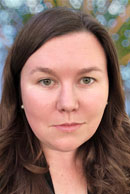
Assistant Adjunct Professor
Email: ekmarder@ucdavis.edu
Office: na Meyer Hall
Phone: 916-913-7390
Research:
My work is focused on regulatory human health risk assessment, with an emphasis on chemical exposures, as well as risk communication. I also have experience in biomonitoring of environmental chemicals and epidemiologic investigations of human health effects of exposures to toxicants such as brominated flame retardants.
Education:
- Emory University – MS and PhD in Environmental Health Sciences (2011-2015)
- University of California, Davis – BS in Environmental Toxicology (2007-2011)
Teaching:
- ETX 135: Health Risk Assessment of Toxicants
- ETX 138 (guest lecturer): Legal Aspects of Environmental Toxicology
- ETX 199/ETX 194H: Special Study for Advanced Undergraduates / Honors Research
Professional Activities:
-
Professional Society Memberships:
- American Chemical Society
- American Public Health Association
-
International Society of Exposure Science
- active member of ISES membership committee and annual conference technical organizing committee (past Board of Directors Councilor, past Chair of Communications & Outreach Committee, past Chair of Student & New Researcher Committee)
- Society of Environmental Toxicology and Chemistry
- Society of Risk Analysis
- Society of Toxicology
-
Journal Activities:
- Reviewer- Environmental Health Perspectives, Environmental Research, Frontiers in Public Health, Journal of Regulatory Toxicology and Pharmacology
- Editor – Frontiers in Public Health (Edior - 2023 Special Topic Issue on Occupational Exposures), Journal of Regulatory Toxicology and Pharmacology (Associate Editor)
Recent Publications:
Select Governmental Reports
Evidence on the Carcinogenicity of Bisphenol A. Office of Environmental Health Hazard Assessment (September 2022). Vanessa Chang, Sarah Elmore, Neela Guha, Jennifer C.Y. Hsieh, Kate Li, M. Elizabeth Marder, Meltem Musa, Karin Ricker, Gwendolyn Osborne, Rose Schmitz, Feng C. Tsai. (link)
Evidence on the Carcinogenicity of Perfluorooctane Sulfonic Acid (PFOS) and Its Salts and Transformation and
Degradation Precursors. Office of Environmental Health Hazard Assessment (September 2021). Sarah Elmore, Neela Guha, Jennifer C.Y. Hsieh, Kate Li, M. Elizabeth Marder, Meltem Musa, Karin Ricker, Gwendolyn Osborne, Rose Schmitz, Feng C. Tsai. (link)
Select Peer-Reviewed Literature
Hood, Robert B., Metrecia L. Terrell, Alicia K. Smith, Sarah Curtis, Karen Conneely, Melanie Pearson, Hillary Barton, Dana Boyd Barr, M. Elizabeth Marder, and Michele Marcus. Elimination of PBB-153; findings from a cohort of Michigan adults. Environmental Research, 2023, 220: 115146. (link)
Li, Kate, Karin Ricker, Feng C. Tsai, ChingYi J. Hsieh, Gwendolyn Osborne, Meng Sun, M. Elizabeth Marder, Sarah Elmore, Rose Schmitz, and Martha S. Sandy. Estimated cancer risks associated with nitrosamine contamination in commonly used medications. International Journal of Environmental Research and Public Health, 2021, 18(18):9465. (link)
Curtis, Sarah W., Dawayland O. Cobb, Varun Kilaru, Metrecia L. Terrell, M. Elizabeth Marder, Dana Boyd Barr, Carmen J. Marsit, Michele Marcus, Karen N. Conneely, and Alicia K. Smith. Genome-wide DNA methylation differences and polychlorinated biphenyl (PCB) exposure in a US population. Epigenetics, 2021, 16(3):338-352. (link)
Greeson, Katherine W., Kristen L. Fowler, Paige M. Estave, S. Kate Thompson, Chelsea Wagner, R. Clayton Edenfield, Krista M. Symosko, Alyse N. Steves, M. Elizabeth Marder, Metrecia L. Terrell ML, Hilary Barton, Michael Koval, Michele Marcus, and Charles A. Easley. Detrimental effects of flame retardant, PBB153, exposure on sperm and future generations. Scientific Reports, 2020, 10: 8567. (link)
Walker, Douglas I., M. Elizabeth Marder, Yukiko Yano, Metrecia L. Terrell, Yongliang Liang, Dana Boyd Barr,
Gary W. Miller, Dean P. Jones, Michele Marcus, and Kurt D. Pennell. Multigenerational metabolic profiling in the Michigan PBB Registry. Environmental Research, 2019, 172, 182–193. (link)
